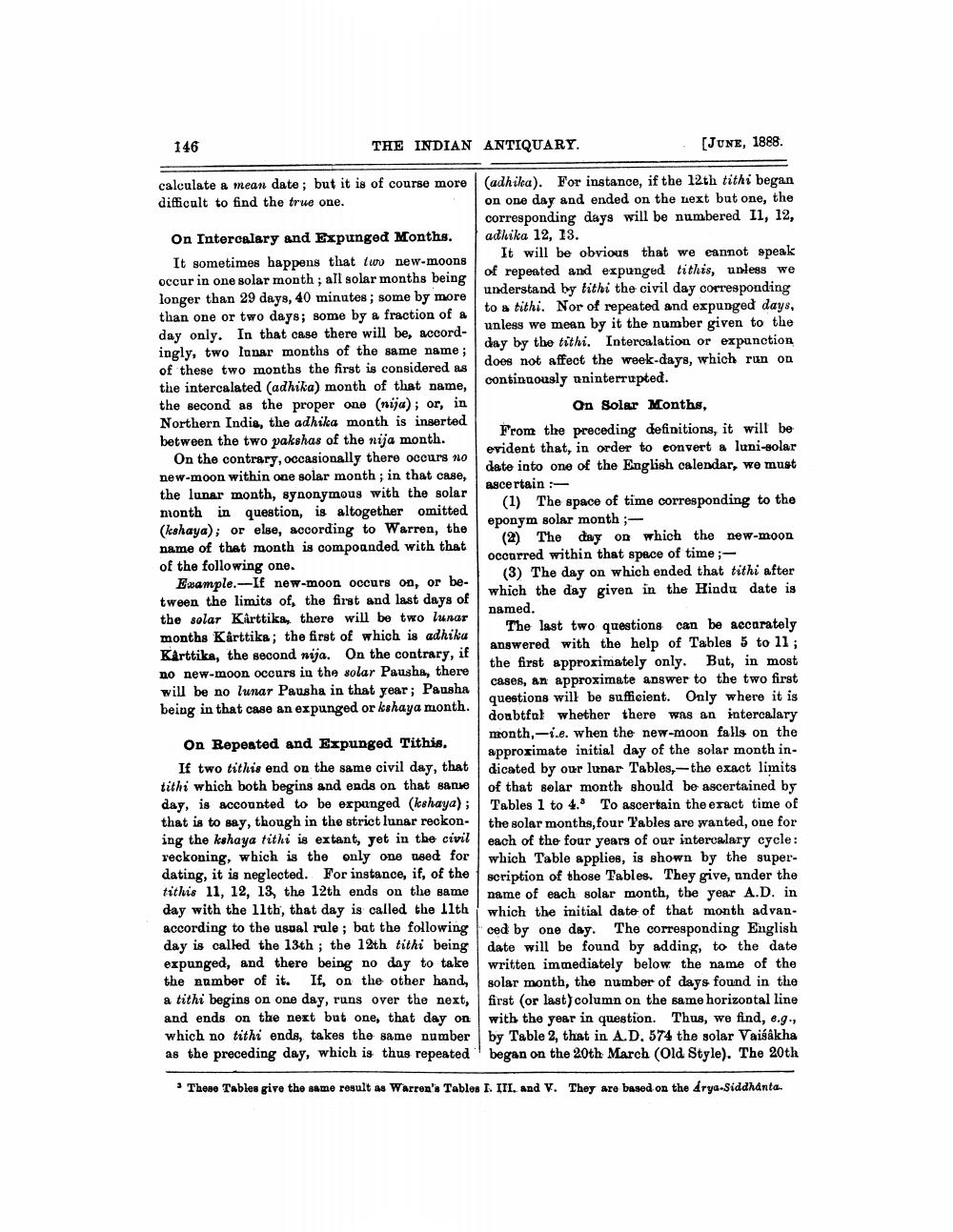________________
146
THE INDIAN ANTIQUARY.
[JUNE, 1888.
calculate a mean date; but it is of course more (adhika). For instance, if the 12th tithi began difficult to find the true one.
on one day and ended on the next but one, the
corresponding days will be numbered I1, 12, On Intercalary and Expunged Months. adlika 12, 13. It sometimes happens that two new-moons
It will be obvious that we eannot speak occur in one solar month; all solar months being
of repeated and expunged tithis, unless we
understand by tithi the civil day corresponding longer than 29 days, 40 minutes; some by more
to a tithi. Nor of repeated and expunged days, than one or two days; some by a fraction of a day only. In that case there will be, accord
unless we mean by it the number given to the ingly, two lunar months of the same name;
day by the tithi. Intercalation or expunction of these two months the first is considered as
does not affect the week-days, which run on the intercalated (adhika) month of that name,
continuously uninterrupted. the second as the proper one (nija); or, in
On Solar Months, Northern India, the adhika month is inserted between the two pakshas of the nija month.
From the preceding definitions, it will be On the contrary, occasionally there occurs no
evident that, in order to convert a luni-solar new-moon within one solar month; in that case,
date into one of the English calendar, we must
ascertain - the lunar month, synonymous with the solar
(1) The space of time corresponding to the month in question, is altogether omitted (kshaya); or else, according to Warren, the
eponym solar month ;
(2) The day on which the new-moon name of that month is compounded with that
occurred within that space of time; of the following one.
(3) The day on which ended that tithi after Ewample.--If new-moon occurs on, or be
which the day given in the Hindu date is tween the limits of, the first and last days of
named. the solar Karttikay there will be two lunar
The last two questions can be accurately months Kürttiks; the first of which is adhika Karttika, the second nija. On the contrary, if
answered with the help of Tables 5 to 11;
the first approximately only. But, in most no new-moon occurs in the solar Pausha, there will be no lunar Pausha in that year; Pausha
cases, an approximate answer to the two first
questions will be sufficient. Only where it is being in that case an expunged or kshaya month.
doubtful whether there was an intercalary
month,-i.e. when the new-moon falls on the On Repeated and Expunged Tithis.
approximate initial day of the solar month inIf two tithis end on the same civil day, that dicated by our lunar Tables,--the exact limits tithi which both begins and ends on that sanse of that solar month should be ascertained by day, is accounted to be expunged (kshaya); Tables 1 to 4. To ascertain the exact time of that is to say, though in the strict lunar reckon the solar months, four Yables are wanted, one for ing the kshaya tithi is extant, yet in the civil each of the four years of our intercalary cycle: veckoning, which is the only one need for which Table applies, is shown by the superdating, it is neglected. For instance, if, of the scription of those Tables. They give, under the tithis 11, 12, 13, the 12th ends on the same name of each solar month, the year A.D. in day with the llth, that day is called the 11th which the initial date of that month advanaccording to the usual rule ; bat the following ced by one day. The corresponding English day is called the 13th ; the 12th tithi being date will be found by adding, to the date expunged, and there being no day to take written immediately below the name of the the number of it. If, on the other hand, solar month, the number of days found in the a tithi begins on one day, runs over the next, first (or last)column on the same horizontal line and ends on the next but one, that day on with the year in question. Thus, we find, e.g., which no tithi ends, takes the same number by Table 2, that in A.D. 574 the solar Vaisakha as the preceding day, which is thus repeated' began on the 20th March (Old Style). The 20th
* These Tables give the same result as Warren's Tables I. III, and V. They are based on the drya-Siddhanta.




